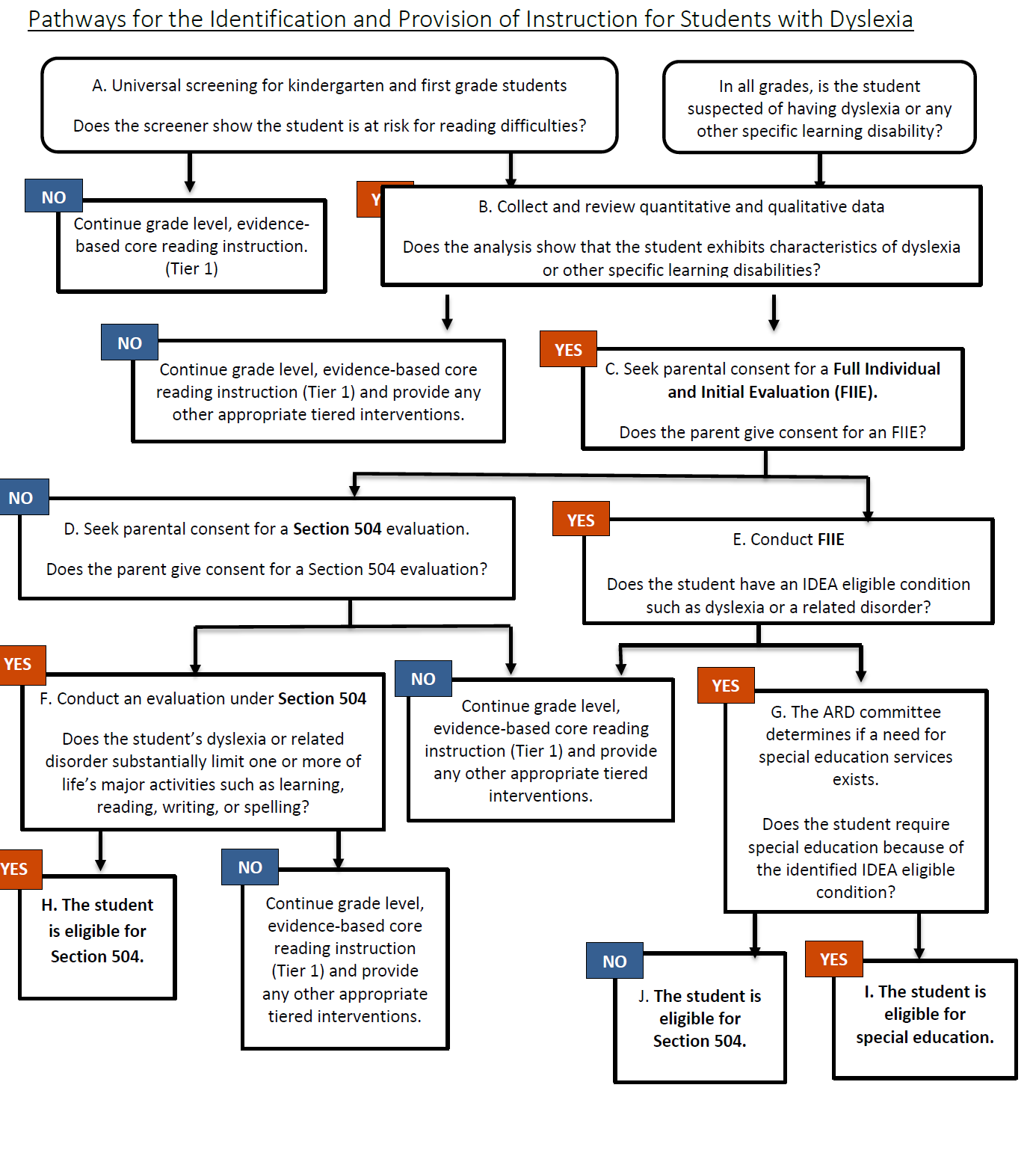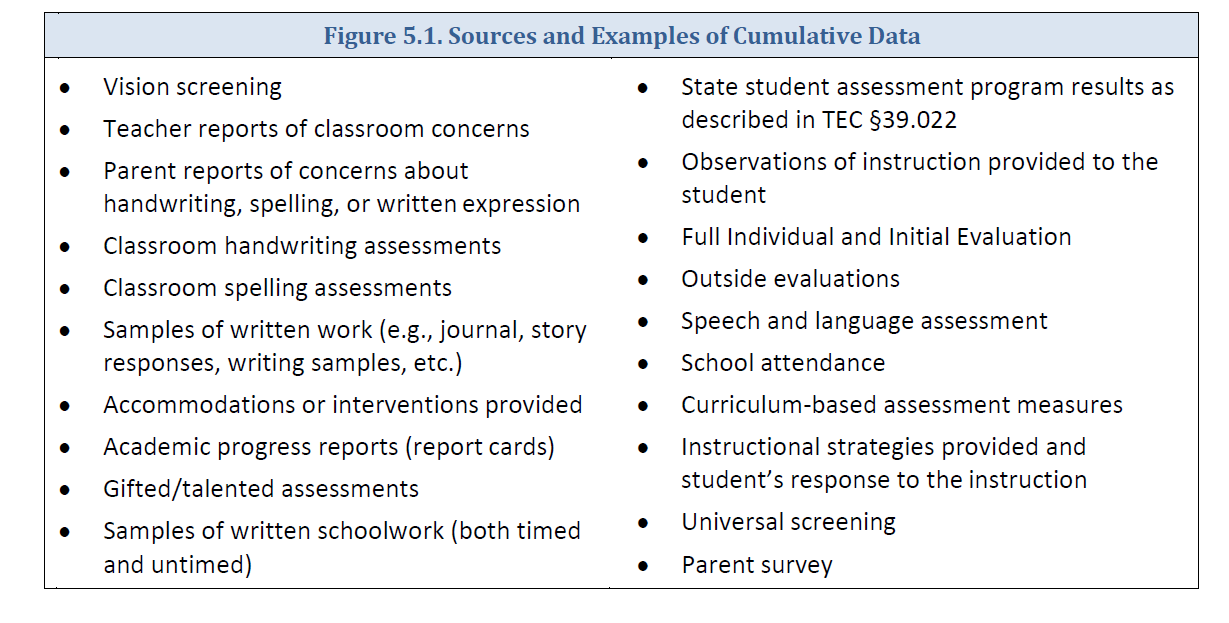-
Considering all data or “pieces to the puzzle” is key!
Per Texas Dyslexia Handbook Update 2021, we use the Universal Screener for reading and dyslexia as a tool in determining testing of suspected students.
There is no one set of data that a referral committee should use for determination of testing qualification. Test grades, reading screeners, classroom observations, attendance, vision screenings, dyslexia characteristic checklists, along with observations from the parents and school employees about the student’s struggles should all be taken into consideration.
There are a few ways students are referred for Dyslexia Evaluation in Bishop CISD:
-
Using the state mandated Kinder, 1st and 7th grade screening process at certain times of the year.
-
Through a campus committee, if they determine the child is not making appropriate growth in reading, writing or spelling, or showing symptoms of being a student with dyslexia.
- If a parent requests dyslexia testing, a committee will convene and review the appropriate data to determine if testing is appropriate.
-
If a teacher feels that there is appropriate data to show lack of growth or characteristics of dyslexia.
The Texas Dyslexia Handbook:
The Texas Dyslexia Handbook is the document that drives referral, evaluation, identification and intervention for students with dyslexia in the state of Texas.
“...anytime the LEA suspects that the student has dyslexia or a related disorder and may need dyslexia intervention services, the LEA must seek parental consent for a Full Individual Initial Evaluation (FIIE) under the IDEA.” (Updates to Dyslexia Handbook, September 23, 2021)
IDEA
-
School suspects student has dyslexia or reading impairment that is substantially limiting their access to education with quantitative data and observations showing areas of need.
-
Student is evaluated through IDEA services
-
ARD committee determines that student can be given FAPE through an Individual Education Plan (IEP), Standard Protocol Dyslexia Intervention, and other interventions to address IEP goals.
-
ARD Committee reviews student’s success and growth each meeting and when student has mastered goals and is at grade level expectations, committee may refer student to support directly through Section 504 for academic support through accommodations
Evaluation
“Science has moved forward at a rapid pace so that we now possess the data to reliably define dyslexia, to know its prevalence, its cognitive basis, its symptoms and remarkably, where it lives in the brain and evidence-based interventions which can turn a sad, struggling child into not only a good reader, but one who sees herself as a student with self-esteem and a fulfilling future.”
—Shaywitz, S.E. Testimony Before the Committee on Science, Space, and Technology, U.S. House of Representatives, 2014
Evaluation Must Address:
When looking at the student data from the evaluation, we look for a pattern of unexpected deficits that show the characteristics of dyslexia.
The state dictates that we use these five identifying questions to show the diagnosis of dyslexia.
-
Does the student demonstrate one of more of the primary reading characteristics of dyslexia in addition to a spelling deficit?
-
Are the reading and spelling difficulties the result of a phonological processing deficit?
-
Are the reading, spelling and phonological processing deficits unexpected?
-
Does the student demonstrate cognitive ability to support age level academic learning?
-
Are there secondary characteristics in reading comprehension and written expression?
After a student is identified as a student with dyslexia, then the IDEA committee that consists of the parent, teacher, administrator, counselor, dyslexia specialist, and any other essential staff from the campus, will create a plan for the student that includes:
-
Intervention
-
Classroom Accommodations
-
Testing Accommodations
-
Parent Recommendations
-
Any other concerns
This plan will be reviewed annually where a student’s progress and accommodations will be discussed and changed to reflect the student’s needs. As a parent, you can always request a meeting to adjust the plan to address any concerns or changes that arise.

Procedures for Identification of Dysgraphia
The process of identifying dysgraphia will follow Child Find procedures for conducting a full individual and initial evaluation (FIIE) under the IDEA. These procedural processes require coordination among the teacher, campus administrators, diagnosticians, and other professionals as appropriate when factors such as a student’s English language acquisition, previously identified disability, or other special needs are present.
The first step in the evaluation process, data gathering, should be an integral part of the district’s or charter school’s process for any student exhibiting learning difficulties. Documentation of the following characteristics of dysgraphia could be collected during the data gathering phase:
• Slow or labored written work
• Poor formation of letters
• Improper letterslant
• Poor pencil grip
• Inadequate pressure during handwriting (too hard or too soft)
• Excessive erasures
• Poor spacing between words
• Poor spacing inside words
• Inability to recall accurate orthographic patterns for words
• “b” and “d” reversals beyond developmentally appropriate time
• Inability to copy words accurately • Inability of student to read what was previously written
• Overuse of short familiar words such as “big”
• Avoidance of written tasks
• Difficulty with visual-motor integrated sports or activities
While schools must follow federal and state guidelines, they must also develop procedures that address the needs of their student populations. Schools shall recommend evaluation for dysgraphia if the student demonstrates the following:
• Impaired or illegible handwriting that is unexpected for the student’s age/grade
• Impaired handwriting that interferes with spelling, written expression, or both that is unexpected for the student’s age/grade

Data Gathering
Schools collect data on all students to ensure that instruction is appropriate and scientifically based. Essential components of comprehensive literacy instruction, including writing, as explicit instruction in writing, including opportunities for children to write with clear purposes, with critical reasoning appropriate to the topic and purpose, and with specific instruction and feedback from instructional staff.
Cumulative Data
The academic history of each student will provide the school with the cumulative data needed to ensure that underachievement in a student suspected of having dysgraphia is not due to lack of appropriate instruction in handwriting, spelling, and written expression. This information should include data that demonstrate that the student was provided appropriate instruction and include data-based documentation of repeated evaluations of achievement at reasonable intervals (progress monitoring), reflecting formal evaluation of student progress during instruction. This cumulative data also include information from parents/guardians. Sources and examples of cumulative data are provided in Figure 5.1.

Formal Evaluation
Formal evaluation includes both formal and informal data. All data will be used to determine whether the student demonstrates a pattern of evidence for dysgraphia.
Academic Skills
• Letter formation
• Handwriting
• Word/sentence dictation (timed and untimed)
• Copying of text
• Written expression
• Spelling
• Writing fluency (both accuracy and fluency)
Cognitive Processes
• Memory for letter or symbol sequences (orthographic processing) Possible Additional Areas
• Phonological awareness
• Phonological memory
• Working memory
• Letter retrieval
• Letter matching
Possible Additional Areas
• Phonological awareness
• Phonological memory
• Working memory
• Letter retrieval
• Letter matching
Dysgraphia Identification
If the student’s difficulties are unexpected in relation to other abilities, the ARD committee must then determine if the student has dysgraphia. The list of questions below must be considered when making a determination regarding dysgraphia:
• Do the data show the following characteristics and consequences of dysgraphia?
• Illegible and/or inefficient handwriting with variably shaped and poorly formed letters Difficulty with unedited written spelling
• Low volume of written output as well as problems with other aspects of written expression
• Do these difficulties (typically) result from a deficit in graphomotor function (hand movements used for writing) and/or storing and retrieving orthographic codes (letter forms)?
• Are these difficulties unexpected for the student’s age in relation to the student’s other abilities and the provision of effective classroom instruction?
If the student with dysgraphia is found eligible for special education, the student’s IEP must include appropriate writing instruction, which might include instruction from a related services provider.
If the student is identified with dysgraphia but is not considered a student with a disability under the IDEA (because the student does not need specially designed instruction), then the student may receive appropriate accommodations and services under Section 504. Students are protected under Section 504 if the physical or mental impairment (dysgraphia) substantially limits one or more major life activities, such as the specific activity of writing. Additionally, the Section 504 committee, in determining whether a student has a disability that substantially limits the student in a major life activity (writing), must not consider the ameliorating effects of any mitigating measures that student is using. Revision of the Section 504 Plan will occur as the student’s response to instruction and to the use of accommodations, if any, is observed. Changes in instruction and/or accommodations must be supported by current data (e.g., classroom performance and dyslexia program monitoring).
Dysgraphia Instruction
Bishop CISD uses critical, evidence-based components of dysgraphia instruction through Reading by Design
Delivery of Intervention The way the content is delivered should be consistent with the principles of effective intervention for students with dysgraphia including the following:
• Simultaneous, multisensory (VAKT) — “Teaching is done using all learning pathways in the brain (visual, auditory, kinesthetic-tactile) simultaneously in order to enhance memory and learning” (Birsh, 2018, p. 19). “Children are actively engaged in learning language concepts and other information, often by using their hands, arms, mouths, eyes, and whole bodies while learning” (Moats & Dakin, 2008, p. 58).
• Systematic and cumulative — “Multisensory language instruction requires that the organization of material follow order of the language. The sequence must begin with the easiest concepts and most basic elements and progress methodically to more difficult material. Each step must also be based on [elements] already learned. Concepts taught must be systematically reviewed to strengthen memory” (Birsh, 2018, p. 19). 71
• Explicit instruction — “Explicit instruction is explained and demonstrated by the teacher one language and print concept at a time, rather than left to discovery through incidental encounters with information. Poor readers do not learn that print represents speech simply from exposure to books or print” (Moats & Dakin, 2008, p. 58). Explicit Instruction is “an approach that involves direct instruction: The teacher demonstrates the task and provides guided practice with immediate corrective feedback before the student attempts the task independently” (Mather & Wendling, 2012, p. 326).
• Diagnostic teaching to automaticity — “The teacher must be adept at prescriptive or individualized teaching. The teaching plan is based on careful and [continual] assessment of the individual's needs. The content presented must be mastered to the degree of automaticity” (Birsh, 2018, p. 27). “This teacher knowledge is essential for guiding the content and emphasis of instruction for the individual student” (Moats & Dakin, 2008, p. 58). “When a reading skill becomes automatic (direct access without conscious awareness), it is performed quickly in an efficient manner” (Berninger & Wolf, 2009, p. 70).
-

